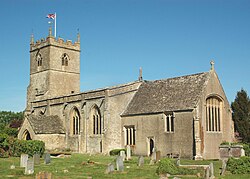Combe, Oxfordshire
| Combe | |
| Oxfordshire | |
|---|---|
 St. Laurence's Church, Combe | |
| Location | |
| Grid reference: | SP4116 |
| Location: | 51°50’24"N, 1°24’11"W |
| Data | |
| Population: | 759 (2001) |
| Post town: | Witney |
| Postcode: | OX29 |
| Dialling code: | 01993 |
| Local Government | |
| Council: | West Oxfordshire |
| Parliamentary constituency: |
Witney |
| Website: | Combe Parish Council |
Combe is a village in Oxfordshire, on the north bank of the winding River Evenlode, about five miles north-east of Witney in that county.
The village green is in the heart of the village, and is the setting for the village's seasonal events and traditions.

Combe has one public house, the Cock Inn. It was built late in the 17th or early in the 18th century.[1] It stands beside the village green.
Combe railway station is on the Cotswold Line, though actually nearer Long Hanborough than Combe if on the right side of the river.
Church and chapel
The parish church is St Laurence. It was built in 1395 for Eynsham Abbey.[2] Its interior has several 15th century wall paintings, including a Doom over the chancel arch.[3] St. Laurence's is a Grade I listed building.[2]
St Laurence's bell tower had a ring of five bells, which ranged in date from 1621 to 1629.[4] It had also an historic clock which may also have been early 17th century.[4] In 1918 a fire damaged the tower, the bells and the clock.[4] The remains of the clock were salvaged, restored and installed in the Museum of the History of Science, Oxford.[4] John Taylor & Co of Loughborough recast the damaged bells as a ring of six in 1924.[4][5] John Smith and Sons of Derby supplied a new clock in 1948.[4]
Combe has also a Methodist chapel.
Economic and social history

Combe House was built in the 16th century and extended in about 1800. It used to be the vicarage.[6]
The Duke of Marlborough's Blenheim estate adjoins the village.
The estate's former sawmill, Combe Mill, is now a working museum.[7] It has alternative power sources: a breastshot water wheel that used to be powered by the River Evenlode,[8] and a steam powered rotative beam engine that was added in 1852.[9]
Big Society
- Sports teams
- Women's Institute
Combe has a number of seasonal festivals held on the green: a children's Maypole dance, a Summer Ball, a funfair in the autumn and a firework display on Guy Fawkes Night.
Another tradition that Combe partakes in is the annual pig run, members of the local farm settlements group together and race pigs along the streets of Combe for entertainment purposes: this is why the Combe football team used to have a pig on its badge.
Outside links
| ("Wikimedia Commons" has material about Combe, Oxfordshire) |
References

- ↑ National Heritage List 1053015: The Cock Inn, The Green
- ↑ 2.0 2.1 National Heritage List 1283757: Church of St Lawrence
- ↑ Sherwood & Pevsner 1974, pp. 551–552.
- ↑ 4.0 4.1 4.2 4.3 4.4 4.5 Beeson & Simcock 1989, p. 36.
- ↑ Davies, Peter (12 December 2006). "Combe S Laurence". Dove's Guide for Church Bell Ringers. Central Council of Church Bell Ringers. http://dove.cccbr.org.uk/detail.php?searchString=Combe&numPerPage=10&Submit=Go&searchAmount=%3D&searchMetric=cwt&sortBy=Place&sortDir=Asc&DoveID=COMBE+++OX. Retrieved 25 March 2012.
- ↑ Sherwood & Pevsner 1974, pp. 552–553.
- ↑ Combe Mill
- ↑ Combe Mill water wheel
- ↑ Combe Mill beam engine
- Beeson, C.F.C. (1989) [1962]. Simcock, A.V.. ed. Clockmaking in Oxfordshire 1400–1850 (3rd ed.). Oxford: Museum of the History of Science. pp. 35–36. ISBN 0-903364-06-9.
- A History of the County of Oxford, Volume 12: Wootton Hundred (South) including Woodstock - Victoria County History ISBN 0-19-722774-0 (pages 75–98)
- Emden C. E.: Combe Church and Village (1970)
- Nikolaus Pevsner: Pevsner Architectural Guides
